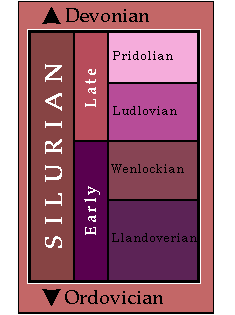





The Llandovery (443-428 million years ago) preserves its fossils in shale, sandstone, and gray mudstone sediment. Its base (beginning) is marked by the appearance of the graptolites Parakidograptus acuminatus and Akidograptus ascensus. The Llandoverian epoch is subdivided into the Rhuddanian, Aeronian, and Telychian stages.

|
Silurian: The chart at left shows the major subdivisions of the Silurian Period. This chart is mapped, to allow you to travel back to the Ordovician or forward to the Devonian. The Silurian Period is part of the Paleozoic Era. |
At the close of the Telychian stage, the appearance of Cyrtograptus centrifugus marks the start of the Wenlockian epoch (428-423 million years ago). The fossils are found in siltstone and mudstone under limestone. Missing from the fossil record of the Wenlock was the conodont Pterospathodus amorphognathoides, present in earlier strata. This is an epoch with excellent preservations of brachiopod, coral, trilobite, clam, bryozoan, and crinoid fossils. The Wenlock is subdivided into the Sheinwoodian and Homerian stages.
The Ludlow (423-419 million years ago) consists siltstone and limestone strata, marked by the appearance of Neodiversograptus nilssoni. There is an abundance of shelly animal fossils. The Gorstian and Ludfordian stages make up the Ludlow epoch.
Platy limestone strata rich in cephalopods and bivalves characterize the Pridolian (419-417 million years ago), the final epoch of the Silurian. It is marked by the appearance of the index fossil Monograptus parultimus, and also by two new species of chitinozoans (marine plankton), Urnochitina urna and Fungochitina kosovensis, which appear at the base or just above the base of the Pridoli.
Find out more about the Silurian paleontology and geology of North America at the Paleontology Portal.


